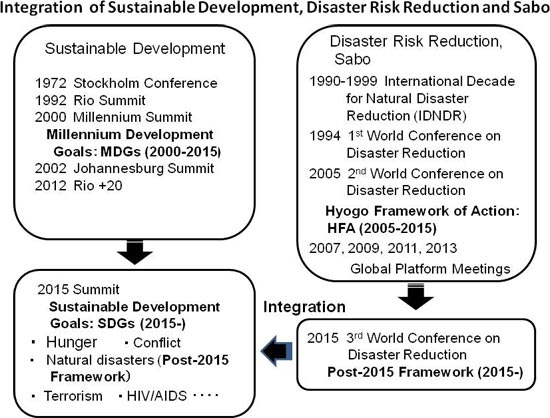About Us
Towards 2015
- Integration of Sustainable Development, Disaster Risk Reduction (DRR) and Sabo -
The year 2015 is an epoch making year: MDGs* (2000-2015) will reach the target date to be replaced by SDGs; HFA** (2005-2015) will reach the target date to be replaced by Post-2015 Framework for DRR; The new Framework for DRR will be integrated into SDGs*** in 2015.
First let us look back the history of UN conferences on sustainable development and the history of international conferences on disaster reduction, then let us think of Sabo in this world trend.
- *MDGs:
- Millennium Development Goals
- **HFA:
- Hyogo Framework of Action
- ***SDGs:
- Sustainable Development Goals
History of UN conferences on sustainable development
Stockholm Conference (1972) dealt with "environment" with the theme "Only One Earth". It adopted "Declaration of Human Environment" and created UNEP in Nairobi, Kenya for its implementation. No specific mention was made about disasters. Rio Summit (1992) focused on harmonious coexistence of "environment" and "development". "Sustainable development" has been a key word since this summit. DRR was mentioned in relation to IDNDR which started two years before in 1990. This was the first conference which referred to DRR. Millennium Summit (2000) was held to mark the new millennium. It adopted Millennium Declaration which resolved to intensify cooperation to reduce the number and effects of disasters. "Road map" of the declaration outlined strategies for early warning, risk mapping, technology transfer etc. MDGs (2000-2015) was adopted to follow up the declaration. Johannesburg Summit (2002) regarded the natural disasters as one of worldwide conditions that pose severe threats to sustainable development together with hunger, conflicts, terrorism, HIV/AIDS etc., and declared to fight against them with priority. Rio+20 (2012) agreed on 26 thematic areas including DRR. It also agreed to establish Sustainable Development Goals (SDGs) as the new goals after MDGs, which should incorporate DRR Framework (2015-) to be adopted at the 3rd World Conference on Disaster Reduction (2015).
History of international cooperation on disaster reduction
Meanwhile, DRR has been implemented acceleratedly over the past two decades to start with IDNDR (1990-1999). IDNDR intended to devote the last decade of the 20th century to the new century under the slogan : Towards a less hazardous World in the 21st Century. Originally proposed by scientific groups, IDNDR emphasized scientific approach to sift from relief to prevention/preparedness. 1st World Conference on Disaster Reduction (1994) reviewed implementation of IDNDR in the middle of the decade. It adopted Yokohama Strategy emphasizing the importance of social approach. 2nd World Conference on Disaster Reduction (2005) reviewed the implementation of Yokohama Strategy and adopted Hyogo Framework of Action (HFA) as a guideline for the next decade (2005-2015). It consists of three Guiding Principles and five Priority for Action under the slogan : Building the Resilience of Nations and Communities to Disaster. Global Platform meeting is being held every two years (2007, 2009, 2011, 2013) to review and accelerate the implementation of HFA.
3rd World Conference on Disaster Reduction will be held in Japan in 2015. It will adopt Post-2015 Framework (2015-) as a new framework after HFA. The new framework will be endorsed by UN General Assembly (2015) and will be incorporated into SDGs to be established by the subsequent UN conference as mentioned above.
Integration of Sustainable Development, DRR and SABO
As mentioned above, sustainable development and DRR will be integrated in 2015. Through this process at the highest level DRR will be well recognized at the national and international levels. The recognition at such levels is essential for further promotion of DRR.
Sabo, an important component of DRR, should go with DRR in this process so that Sabo will also be well recognized widely even by leaders at national and international levels.
For Sabo to go with DRR, it is suggested that ISN members will participate in preparatory works in each country for the 4th Session of Global Platform (May 2013 in Geneva) where each country will present a country report and make statements on the achievement of HFA and will make proposal on Post-2015 Framework. Voices of Sabo side should be reflected in these reports, statements and proposal.
It is also suggested that INTERPRAEVENT and other meetings will discuss on Post-2015 Framework so that importance of Sabo may be mentioned in the Framework and Sabo works may be included in priority actions.
Main issues currently addressed include "mainstreaming of DRR in development policies and plans" and "promotion of community DRR". As you agree, Sabo by nature has been pursuing safety and development of communities with initiatives and participation of community people as much as possible. Sabo is thus the forerunner in DRR. This point can be highlighted in the discussions at national and international meetings.
Conclusion
Environment preservation, disaster reduction and Sabo can be best implemented to fulfill their respective missions by integrating themselves into overall sustainable development, rather than going alone separately. 2015 offers a good opportunity for such integration. Please keep watch on the progress of activities towards 2015 and take part in them as appropriate according to your position, expertise and interest.
I expect "sediment-related disasters", "Sabo" and similar words will appear in the documents of the 4th Session of Global Platform(2013) and Post-2015 Framework(2015) and further SDGs (2015).
The ISN editorial members will be more than happy if you will come to Japan as a member of government delegation at the 3rd World Conference on Disaster Reduction in May 2015.

Figure